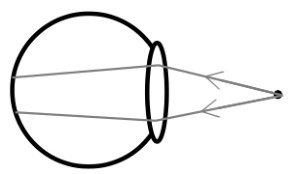-
Converging lenses: They are fatter at the center, e.g., biconvex lens, plano-convex lens, etc.
-
Diverging lenses: They are thinner at the center, e.g., biconcave lens, plano-concave lens, etc.
-
Principal focus (or focal point): It is the point where all rays close to and parallel to the principal axis converge after refraction from a converging lens.
-
Focal length: Focal length is the distance between the optical center of the lens and the principal focus.
-
Important rays for converging lens are:
-
An incident ray that passes straight through optical centre.
-
An incident ray parallel to principal axis is refracted to pass through principal focus (F).
-
An incident ray passing through principal focus (F) is refracted to become parallel to principal axis.

-
Important rays for diverging lens are:
-
An incident ray that passes straight through optical centre.
-
An incident ray parallel to principal axis is refracted such that it appears to be coming from the principal focus (F) on the side of the object.
-
An incident ray aiming for principal focus (F) on far side is refracted to become parallel to principal axis.

-
Human eye
-
Parts and their functions:
-
a crystalline biconvex lens to focus light
-
a retina having light sensitive cells acts as a screen
-
ciliary muscles to change the curvature of the lens
-
an iris controls the amount of light entering the eye
-
-
Working: The human eye can change the lens curvature (and hence the principal focus) to view objects that are far or near.
-
-
Shortsightedness (Myopia): The eye can focus light from near objects but not from objects that are far.

-
-
It is corrected like this.

-
-
Farsightedness (Hyperopia): The eye can focus light from far objects but not from those that are near.

-
-
It is corrected like this.

-
-
Linear magnification (m)
m = (image height) / (object height)
m = (image distance) / (object distance)
Note: “m = 1” means image is same size as the object. “m = 2” means image is twice the size of the object and so on…
-
Properties of an image
-
inverted / upright
-
real / virtual
-
magnified / diminished / same size
-
greater / same / less distance from lens compared to the object
-
-
Virtual images are always upright and real images are always inverted.
-
Lenses are used in cameras, projectors, photocopiers, telescopes, etc.
Go back to table of contents



